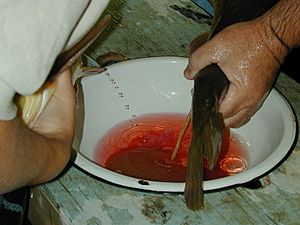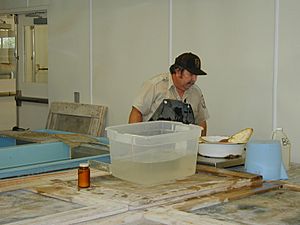- This page was last modified on 17 October 2025, at 10:18. Suggest an edit.
Dexter National Fish Hatchery & Technology Center facts for kids
The Dexter National Fish Hatchery & Technology Center is a special place in Dexter, New Mexico. It's run by the U.S. Fish and Wildlife Service. This center helps save fish that are in danger of disappearing forever. These fish are called endangered or threatened.
It's the only place in the United States that focuses only on these special fish. Scientists here study how these fish live and grow. They also look closely at their genetics. The center acts as a safe home for 16 different kinds of fish that need help. The Dexter National Fish Hatchery started in 1931. Back then, it helped provide fish for fishing. But in the 1970s, new rules changed its focus to protecting endangered fish.
Fish Species at Dexter
As of January 1, 2007, the Dexter National Fish Hatchery and Technology Center was home to 16 threatened and endangered fish species. These include:
- Colorado pikeminnow (Ptychocheilus lucius)
- Razorback sucker (Xyrauchen texanus)
- Bonytail chub (Gila elegans)
- Virgin river chub (Gila robusta seminuda)
- Chihuahua chub (Gila nigrescens)
- Pahranagat roundtail chub (Gila robusta jordani)
- Leon Springs pupfish (Cyprinodon bovinus)
- Comanche Springs pupfish (Cyprinodon elegans)
- Desert pupfish Cyprinodon macularius
- Rio Grande Minnow (Hybognathus amarus)
- Big bend gambusia (Gambusia gaigei)
- Pecos gambusia (Gambusia nobilis)
- Gila topminnow (Poeciliopsis occidentalis)
- Beautiful shiner (Cyprinella formosa)
- Woundfin (Plagopterus argentissimus)
- Pecos bluntnose shiner (Notropis simus pecosensis)
The center keeps a healthy group of parent fish, called a broodstock, for each species. They raise new fish from these parent groups. Their goal is to release these new fish back into their natural homes.
The team at the hatchery watches the fish very closely. They learn how to help them have babies and grow. They also check the water quality, what the fish eat, and how their bodies work. They also manage the fish's genetics.
Fish Genetics at Dexter
Dexter has a special lab called the Conservation Genetics Laboratory. This lab has modern tools to study fish DNA. They look at tiny parts of the DNA called microsatellite markers. This information helps them make sure the fish they raise are genetically healthy. It also helps them keep the 16 endangered fish species pure.
One short-term goal for the genetics program is to create a "genetic baseline" for all fish at Dexter. This means they will map out the normal genetic makeup for each species. This information helps them keep the fish diverse. It also helps them avoid problems like "domestication selection." This happens when fish get too used to living in captivity. They also avoid "genetic drift," which is when genetic variety is lost.
In the long term, the genetics lab wants to help with bigger plans to save fish in the Southwest. They use science and technology to apply genetic rules to fish management. This helps make sure their efforts to save these species are successful.
Helping Fish Spawn
The time when fish lay eggs, called spawning, usually happens from March to mid-June at Dexter. The center uses two main ways to help fish spawn. One is called "induced spawning." This means scientists help the fish lay eggs. The other is "natural spawning," where fish lay eggs on their own. They help 17 different threatened and endangered species spawn here.
They raise special parent fish, called broodfish, just for spawning. Each year, they help over 350 pairs of broodfish lay eggs using the induced method. These pairs can produce more than 3.5 million eggs! This number doesn't even include the fish that spawn naturally in outdoor ponds. Some of the new fish from each spawning are kept at the station. This helps make sure there are always new parent fish with good genetic variety. They make sure to use different pairs of fish each year. This stops the same fish from spawning over and over.
The center has been very successful in helping fish spawn. This success means they can release many fish back into their natural homes. Without this kind of help, these fish would almost certainly become extinct.
Tagging and Marking Fish
The center uses four different ways to tag or mark fish. These marks help scientists identify fish. Biologists in the wild and at the center can tell if a fish was raised at the hatchery or if it was born in the wild.
- Calcien Marking: This is a special liquid marker that sticks to the bones of the fish. It makes parts like fins glow when seen under a blue light.
- Visible Implant Elastomer (VIE): This is a colored, glowing material injected into the fish's skin. It hardens into a clear mark that glows under blue light.
- Passive Integrated Transponder (PIT): These are tiny microchips, about the size of a grain of rice. They are injected into the fish and can be read with a special scanner.
- Wire Tagging: A small magnetic wire tag is injected just under the fish's skin. These tags are read using a hand-held detector.



